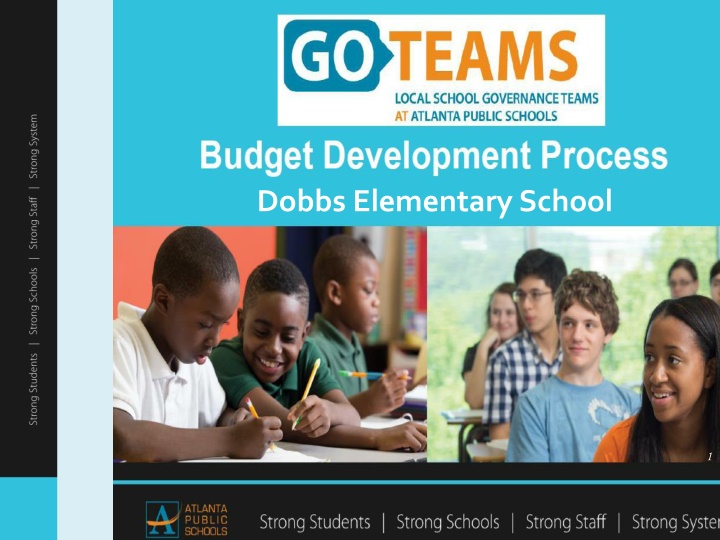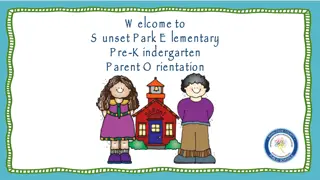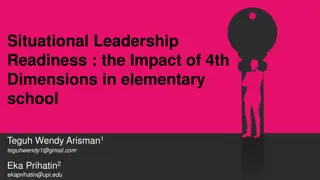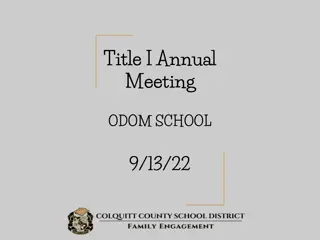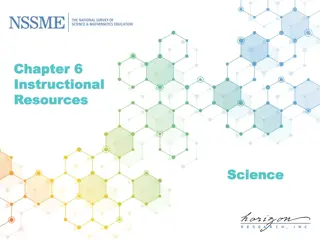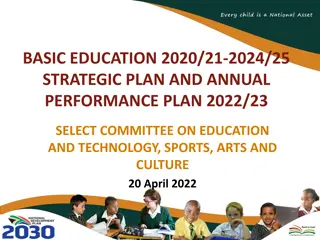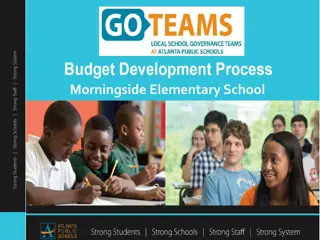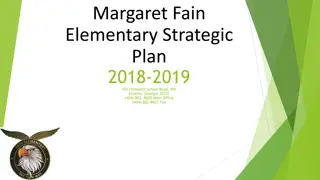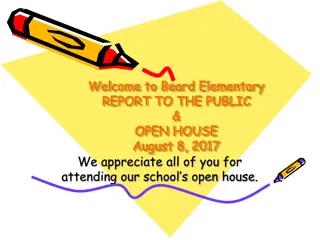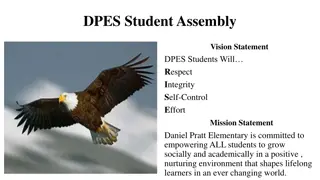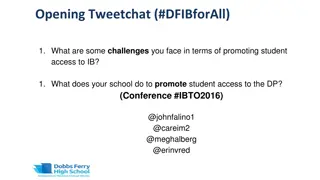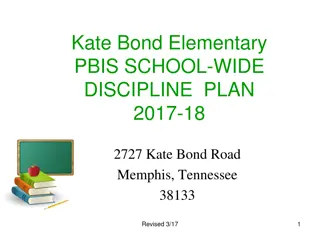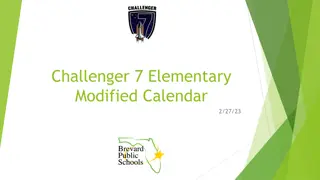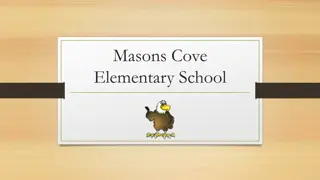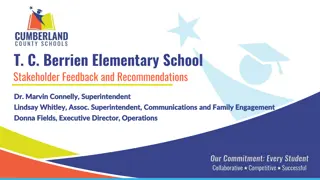Dobbs Elementary School Strategic Plan
Dobbs Elementary School Strategic Plan focuses on fostering a culture of excellence through collaboration, academic achievement, and personal responsibility. The plan aims to provide a 21st-century learning environment that integrates respect, high academic standards, and technological innovation. Key priorities include implementing STEM programs, enhancing student learning experiences, and ensuring college and career readiness.
Download Presentation

Please find below an Image/Link to download the presentation.
The content on the website is provided AS IS for your information and personal use only. It may not be sold, licensed, or shared on other websites without obtaining consent from the author.If you encounter any issues during the download, it is possible that the publisher has removed the file from their server.
You are allowed to download the files provided on this website for personal or commercial use, subject to the condition that they are used lawfully. All files are the property of their respective owners.
The content on the website is provided AS IS for your information and personal use only. It may not be sold, licensed, or shared on other websites without obtaining consent from the author.
E N D
Presentation Transcript
Norms This is a meeting of the GO Team. Only members of the team may participate in the discussion. Any members of the public present are here to quietly observe. We will follow the agenda as noticed to the public and stay on task. We invite and welcome contributions of every member and listen to each other. We will respect all ideas and assume good intentions. 2
GO Team Budget Development Process YOUR SCHOOL STRATEGIC PLAN is your roadmap and your role. It is your direction, your priorities, your vision, your present, your future. Step 1: Data Review Step 2: Strategic Plan Review Step 3: Budget Parameters Step 4: Budget Choices
FY21 Budget Development Process Principal s Role Design the budget and propose operational changes that can raise student achievement Flesh out strategies, implement and manage them at the school level Focus on the day-to-day operations Serve as the expert on the school Hire quality instructional and support personnel The GO Team s Role: Focus on the big picture (positions and resources, not people) Ensure that the budget is aligned to the school s mission and vision and that resources are allocated to support key strategic priorities 4
J.W. Dobbs Elementary School Strategic Plan (South Atlanta Cluster) Cluster Mission & Vision District Mission & Vision School Mission & Vision To cultivate a universal culture of excellence through collaboration, academic achievement, personal responsibility, respect and a commitment to service To foster a 21st century learning environment that integrates a culture of mutual respect, high academic standards, and technological innovation. With a caring culture of trust and collaboration, every student will graduate ready for college and career. A high-performing school district where students love to learn, educators inspire, families engage and the community trusts the system To provide rigorous, innovative, and engaging learning experiences designed to cultivate life-long learners. A high-performing cluster where every students graduate with college and career readiness Signature Program: Science, Technology, Engineering and Mathematics (STEM) Key Performance Measures School Strategies School Priorities 1A. Provide remediation and acceleration as indicated by data through weekly interventions 1B. Ensure that students are writing across the curriculum to improve their ability to respond to extended and constructed responses 1C. Implement Standards-Based practices (skills) Kdg-5th 1D. Implementing guided reading and close reads to improve comprehension 1E. Work closely with KidzMatter to reinforce core content after school 1F. Implement Number Talks to increase math fluency 1G. Utilize Gifted and Talented talent development program 1H. Utilize I-Ready and TutorMate to assist with interventions 1I. Ensure Teacher Tutors are utilized to assist in Reading. 2A. Implement STEM enriched curriculum 2B. Implement integrated, project-and problem-based learning projects 2C. Implement rigorous and real-world interdisciplinary projects and units 2D. Integrate technology throughout the curriculum 2E. Implement the Engineering Design Process 3A. Implement Social and Emotional Learning (SEL) Increase ELA, Math, & Science Performance in Proficient and Distinguished categories on Georgia Milestones 1. Improve student mastery of core content knowledge Implement STEM program model Prepare all students to have the essential life skills to be self-aware, collaborative, and accepting of diversity 2. 3. Academic Program Increase Progress (percent of students meeting typical or high growth on Milestone EOGs) Increase students scaled scores on STAR Reading, Early Literacy, and Mathematics on each administration Fall to Winter to Spring 4A. Provide targeted professional learning opportunities focused on the implementation of standards and STEM 4B. Implement intentional vertical and horizontal alignment collaboration throughout school and cluster 4C. Provide targeted professional learning opportunities focused on mathematics & reading through our various partnerships 4D. Increase reading, math and science endorsements and certifications 4E. Emphasis on teachers content expertise (building capacity) 5A. Leverage professional networks of Dobbs staff for referrals 5B. Check professional references of applicants 5C. Look at previous student performance data, if applicable 5D. Model a lesson as a component of the interview Talent Management Teacher Effective Measure (TEM scores) 4. Build teacher capacity in core content areas, particularly reading, math and science Recommend high-quality staff for vacant positions Results of Student Perceptions on School Climate Surveys 5. Feedback from Classroom Observations
J.W. Dobbs Elementary School Strategic Plan (South Atlanta Cluster) Cluster Mission & Vision District Mission & Vision School Mission & Vision To cultivate a universal culture of excellence through collaboration, academic achievement, personal responsibility, respect and a commitment to service To foster a 21st century learning environment that integrates a culture of mutual respect , high academic standards, and technological innovation. With a caring culture of trust and collaboration, every student will graduate ready for college and career. A high-performing school district where students love to learn, educators inspire, families engage and the community trusts the system To provide rigorous, innovative, and engaging learning experiences designed to cultivate life-long learners. A high-performing cluster where every students graduate with college and career readiness Signature Program: Science, Technology, Engineering and Mathematics (STEM) Key Performance Measures School Strategies School Priorities 6A. Develop business and education partnerships 6B. Ensure the necessary technology infrastructure and equipment are available 6C. Utilize Care Center @Dobbs to promote healthy living to increase attendance 6D. Use wrap-around services to assist students and their families with emotional, mental, and physiological needs 6E. Utilize the parent liaison to build and strengthen school-home relationships 6F. Design and implement behavior goals for all students to promote positive interactions with adults and peers 7A. Implement PBL Units, STEM Days & Celebrations 7B. Visit STEM certified schools 7C. Design lessons that focus on technology with ETS or core content specialists Increase Student Attendance Systems & Resources Increase Number of School Partnerships 6. Build systems identifying and addressing root causes to promote social and academic growth Build systems and resources to support STEM implementation Increase Quality and Number of Projects Produced during STEM Days 7. Increase Student Attendance 8A. Build community awareness, knowledge and support for STEM 8B. Build parent capacity to understand student needs academically & behaviorally through curriculum nights, workshops with the parent liaison, and Kidz Matter 8C. Implement student behavior and attendance initiatives 9A. Implement Social and Emotional Learning (SEL) for school staff, students, and parents through the use of Mind Yeti, Second Step, etc. 9B. Increase effective external communication through RoboCall, Remind 101, Flyers, Class Dojo, and Infinite Campus 9C. Improve customer service systemically Improve Culture Climate Survey Scores for Students Getting Along with Other Students 8. Inform and engage the school community Develop a positive, informed and engaged school culture Culture 9. Improve Climate Survey scores for teachers perceptions of student behavior
FY21 Priorities & SMART Goals ( Top 2 Priorities & SMART Goals for FY21) School Priorities SMART Goals 1. Improve student mastery of core content knowledge in all grades as measured by school, district, and state data. Students will increase ELA, Math, & Science Performance by 5% in the proficient and distinguished categories on the GA Milestones by May 2021. 4. Build teacher capacity in core content areas, particularly reading, math and science Teachers will increase their capacity in content areas by 2-3% as measured by STAR and/or Interim Assessment data monthly during each administration. 7
FY21 Budget Parameters FY21 School Priorities Rationale 1.Improve student mastery of core content knowledge in all grades as measured by school, district, and state data. Students are showing success in literacy and math as evidenced by increased data in grade K-2, but all grade levels (tested) and other core content areas are not showing evidence of success. 8
FY21 Budget Parameters FY21 School Priorities Rationale Build teacher capacity in core content areas, particularly reading, math and science As a school, consistent increased achievement in core content areas has not been evident. Many of the teachers have not had enough opportunities to improve their teaching skills via professional learning and coaching. 9
Discussion of Budget Summary (Step 4: Budget Choices) 10
Executive Summary This budget represents an investment plan for our school s students, employees and the community as a whole. The budget recommendations are tied directly to the school s strategic vision and direction. The proposed budget for the general operations of the school are reflected at $______ This investment plan for FY21 accommodates a student population that is projected to be _____ students, which is a increase/decrease of ______ students from FY20. 11
Dobbs School Allocation FY2021 TOTAL SCHOOL ALLOCATIONS School Location Level FY2021 Projected Enrollment Change in Enrollment Total Earned Dobbs Elementary School 0104 ES 424 15 $5,138,072 SSF Category Base Per Pupil Grade Level Kindergarten 1st 2nd 3rd 4th 5th 6th 7th 8th 9th 10th 11th 12th Poverty Concentration of Poverty EIP/REP Special Education Gifted Gifted Supplement ELL Small School Supplement Incoming Performance Baseline Supplement Transition Policy Supplement Total SSF Allocation Count 424 Weight $4,586 Allocation $1,944,462 66 68 56 82 75 77 0 0 0 0 0 0 0 358 0.60 0.25 0.25 0.25 0.00 0.00 0.12 0.07 0.07 0.07 0.07 0.07 0.07 0.50 0.06 1.05 0.03 0.60 0.60 0.15 0.40 0.10 $181,605 $77,962 $64,204 $94,013 $0 $0 $0 $0 $0 $0 $0 $0 $0 $820,893 $54,561 $592,281 $8,668 $11,006 $49,971 $6,879 $47,694 $0 $0 $0 $3,954,201 123 63 4 18 10 26 0 No No 12
School Allocation Additional Earnings Signature $137,000 Turnaround $0 Title I $288,900 Title I Holdback -$43,335 Title I Family Engagement $6,000 Title I School Improvement $0 Title IV Behavior $0 Field Trip Transportation $10,951 Dual Campus Supplement $0 District Funded Stipends $10,200 Reduction to School Budgets $0 Total FTE Allotments 10.55 $774,155 Total Additional Earnings $1,183,871 Total Allocation $5,138,072 13
Whats Next? January: GO Team Initial Budget Session (Jan. 21st-31st) February: One-on-one Associate Superintendent discussions Cluster Planning Session (positions sharing, cluster alignment, etc.) Program Manager discussions and approvals GO Team Feedback Session HR Staffing Conferences (February 24th - March 2nd) March: Final GO Team Approval (March 3rd - March 13th) 15
Focus Area Descriptors Strategic Plan Categories Academic Program Our students will be well-rounded individuals who possess the necessary academic skills and knowledge and are excited about learning. Talent Management who are capable of advancing ever-increasing levels of achievement for students of all backgrounds. Systems & Resources also making decisions (including resource allocations) that are grounded in a strategic academic direction and data. Culture We will build trust with the community, and we will have engaged stakeholders (employees, students, parents, community members, partners, etc.) who are invested in the mission and vision and who support the creation of student-centered learning communities. District Descriptions of Categories We will retain an energized and inspired team of employees We will improve efficiency (productivity, cost, etc.) while 16
Description of Strategy Categories 1. Budget Parameters FY21 funding priorities from the school s 3-5 year strategic plan, ranked by the order of importance 2. Strategies Lays out specific objectives for schools improvement 3. Request The Ask . What needs to be funded in order to support the strategy? 17
FY21 Budget Parameters FY21 School Priorities Rationale 1.Improve student mastery of core content knowledge in all grades as measured by school, district, and state data. Students are showing success in literacy and math as evidenced by increased data in grade K-2, but all grade levels (tested) and other core content areas are not showing evidence of success. 18
FY21 Budget Parameters FY21 School Priorities Rationale Build teacher capacity in core content areas, particularly reading, math and science As a school, consistent increased achievement in core content areas has not been evident. Many of the teachers have not had enough opportunities to improve their teaching skills via professional learning and coaching. 19
FY21 Strategic Plan Break-out Priorities Focus Area Strategies Requests Amount Purchase an additional Teacher (example- please remove) Implementation of guided reading (Writers Workshop training for all staff) (example- please remove) $84, 134 (example- please remove) Increase level of rigor and relevance (example- please remove) Academics (example- please remove) Provide remediation and acceleration as indicated by data through weekly interventions Ensure that students are writing across the curriculum to improve their ability to respond to extended and constructed responses Implement Standards-Based practices (skills) Kdg-5th Content-specific Instructional and Support Personnel $314,901 Improve student mastery of core content knowledge Academics Content-specific technology and curricular resources $34,722 Provide targeted professional learning opportunities focused on the implementation of standards and STEM Implement intentional vertical and horizontal alignment collaboration throughout school and cluster Provide targeted professional learning opportunities focused on mathematics & reading through our various partnerships Increase reading, math and science endorsements and certifications Teachers will attend additional targeted content area trainings to specifically support STEM implementation and to improve their teaching skills via professional learning and coaching. Build teacher capacity in core content areas, particularly reading, math and science Teacher Capacity $9,000 20
FY 2021: Purpose of Reserve Funds To account for the district s overall revenue uncertainty & help to mitigate potential losses at leveling 2% of school s SSF allocation has been budgeted for NonStaffing Use of these funds is subject to District Approval
Plan for FY21Reserve Priorities Focus Area Strategies Requests Amount Implementation of guided reading (Writers Workshop training for all staff) (example- please remove) Purchase an additional Teacher (example- please remove) $84, 134 (example- please remove) Increase level of rigor and relevance (example- please remove) Academics (example- please remove) District Mandated Reserve for Potential Leveling NA NA NA $79,804 22
Plan for FY21 Title I Holdback and Family Engagement Funds Priorities Focus Area Strategies Requests Amount Implementation of guided reading (Writers Workshop training for all staff) (example- please remove) Purchase an additional Teacher (example- please remove) Increase level of rigor and relevance (example- please remove) $84, 134 (example- please remove) Academics (example- please remove) As Needed When Released -$43,335 Reserved Funds NA NA 23
Questions to Consider 1. Are our school s priorities (from your strategic plan) reflected in this budget? a. Are new positions and/or resources included in the budget to address our major priorities? b. Do we know (as a team) the plan to support implementation of these priorities beyond the budget (ex. What strategies will be implemented)? c. What tradeoffs are being made in order to support these priorities? 2. How are district and cluster priorities reflected in our budget? a. Cluster priorities- what staff, materials, etc. are dedicated to supporting our cluster s priorities? b. Signature programs- what staff, materials, etc. are dedicated to supporting our signature program? c. Are there positions our school will share with another school, i.e. nurse, counselor? 24
Questions? Thank you for your time and attention. 25
